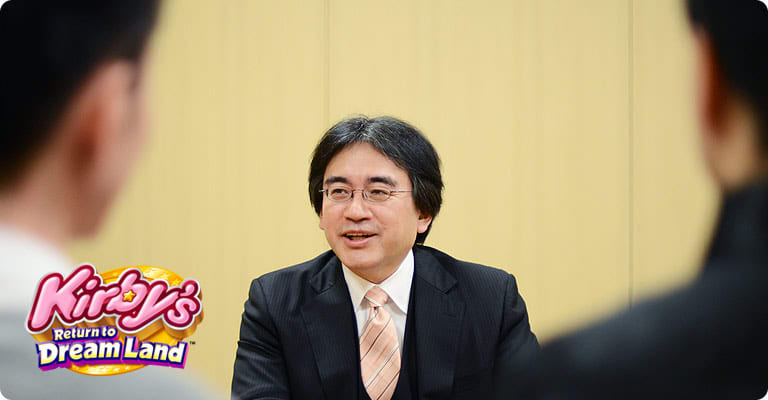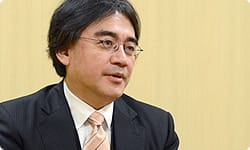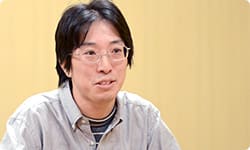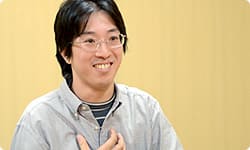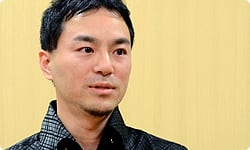Programmers Never Say No
Now I'd like to talk to those of you who played that role.
All right. I'm Hiroaki Nakano, who worked on the programming. I created the various systems necessary for making Kirby move. And as a leader, I coordinated all the programmers.
The character Kirby has lots of moves, like inhaling things and copying abilities, so the basic system of the programming tends to get complicated. Did you resent the specifications?
The specifications were complicated, but we didn't resent them. (laughs) The programmers had to wrack their brains, but there weren't any unexpected upendings of the tea table, and the programmers worked really hard, so we were able to see it to the end. When it comes to programming, four-person simultaneous gameplay was quite a challenge.
More than the difficulties entailed by programming the Kirby character, you had to make it playable by up to four people.
Yes.
Earlier, when we made Kirby's Adventure10, we made the Copy Abilities system for the first time, but when I consulted Suga-san11, who was the main programmer and leader, he said something I will remember my whole life. He said, "Are we…really going to do this?"
10. Kirby's Adventure™: An action game released for the Famicom system in May 1993.
11. Mr. Hiroaki Suga: Producer of Kirby's Return to Dream Land.
(laughs)
Viewed from development in the days of the Famicom system, I think he meant that the amount of work involved would equal that of many games, and those difficulties in programming have continued to this day as a kind of Kirby tradition. And this time it's multi-player.
Yes. The Copy Abilities system was hard, but several of the other programmers and I were involved in the three lost Kirby games, so we had some idea of how to make it. But the sales points this time—that four people can play Kirby, with each one jumping in and out at any time—are new, so we had to do tons of stuff.
As a programmer, it's a whole slew of bad circumstances.
Yes. Earlier, I mentioned that there weren't any unexpected upending the tea table, but at first no one mentioned simultaneous four-person gameplay.
As a programmer, I was holding my head (laughs), but it makes sense that the players would want to play simultaneously with their friends.
To be honest, I thought it would be difficult to have everyone be Kirby, inhaling and copying.
If the programmers had said it was impossible, I would have given up, but Nakano-san thought a moment and said all cool-like, "It can be done!" Just like you once said, Iwata-san! (laughs)
The legend of the programmers who never say no continues. (laughs) (Editor's note: Iwata-san was the one of the actual forerunners who started this legend. In an interview column about him by copywriter Shigesato Itoi, Iwata-san mentioned that if a programmer says no, it would make it harder for ideas to come up. The full column is available online in Japanese, at Itoi-san's website "Hobo Nikkan Itoi Shinbun" (Almost Daily Itoi Newspaper)
Yes. (laughs) I'm relieved that in the end we made it so four players can enjoy playing Kirby.
All right, Kamitake-san?
Okay. I'm Tadashi Kamitake, design leader. The first time I worked on a Kirby game was as a designer for Kirby Super Star Ultra for the Nintendo DS system. I mostly managed schedules and supervised design.
When you saw the output from the three games that never made it out the door, did you get weak in the knees?
To be honest, yes! And I wasn't the only one. Lots of people did.
Yes, I got that impression that, at first, everyone was a bit uneasy.
I think we were able to get over that because so many of the members of the team, in addition to Nakano-san and Kamitake-san, were relatively young. The power of youth was important in seeing us through smoothly this time.
That's right. It's too bad that the third attempt at a new Kirby game didn't come together, but this time we were confident we could do it!
Being young is incredible! (laughs)
(laughs)
It truly is.
But the team also had veterans. In some ways, they would be the ones who best know the Kirby tradition.
That's right. At first, a lot of people were worried. But we went to Tokyo to talk with you once, you had prepared an opportunity for me to talk with them.
Yes. When the project kicked off, I hosted a round table of sorts. Veterans who had worked on the series in the past were there and we got a feel for where we all stood.
I noticed they were worried about the same things we were and that they wanted to go in the same direction. Thanks to that discussion, we were able to establish the past games as a foundation and proceed with clearing each thing we were worried about.
Partway along, it seemed like you suddenly sped up. Kumazaki-san, about when did you sense that?
About October of last year. We had reached a point where I thought, "This'll work!" and was able to face everyone and explain what kind of content to shoot for, and the size of the team grew.
You could assert to the team that if you fleshed it out, it would become a product.
Yes. We tried something interesting to track progress. We made an in-house website for the project team. There were pages for showing at a glance the current state of the team's progress by posting screen shots as a history of development, reporting in a blog format on the state of progress, and putting up specifications you were thinking about or art by the designers.
A development diary.
That's right. One reason we did that was, because of the hard experiences in the past with the three incomplete Kirby games, we wanted to be able to tell visually at what stage we were. We updated it without missing a single day after the project started. That way, the whole team could say, "Oh, it's really coming together!" It was a way for the whole team to get excited about the game's progress.
It's a visualization technique. It's important to set a clear goal and make it easy to understand where you are at any time. It must have been like a car GPS navigation system.
Exactly. I talk a lot, and I have an enthusiastic and persistent personality (laughs), so I never ceased stressing the greatness of this game to the team. I wanted everyone to think, "It'll be all right if we leave it to Kumazaki."
Nakano-san, when did you realize you could leave it to Kumazaki-san?
From the beginning. When I saw the proposal, I simply thought, "I wanna play that kind of Kirby game!" I was like (pumping his fist), "Let's give it everything we've got!" (laughs)
I think we could do it because of this kind of encouragement on the team.
Kawase-san, as you watched from the sidelines, at what stage did it seem like they had hit on a trajectory?
This is an important point. Making Kirby's movement feel right, thanks to previously existing resources, came together at a fairly early stage.
Oh, okay. Something else Miyamoto-san says, is "A game gets better the second time you make it." I feel like the previous games live on in this one. The third lost game was painfully close to completion, so I didn't want it to end there. This time, the fourth time, the structure has changed, but the third game's output is at work in it.
